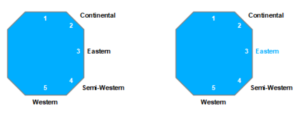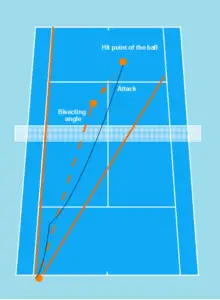Learn backhand slice approach shot
The perfect slice attack ball in tennis
The perfect slice attack ball in tennis
On TV, it always looks elegant and easy when tennis pros attack with a targeted slice and advance to the net, then finish the point with a volley. But the slice is much more difficult when you stand on the tennis court yourself and try to place the tennis ball accordingly.
Tennis beginners learn the slice attack ball only after they have built up initial confidence in the serve, forehand, backhand, volley and smash. The slice attack ball is used much more often on the backhand, as the movement there seems more natural.
In the following, we will explain to tennis beginners how to play the perfect slice attacking ball in tennis: from the grip position, the backswing, the motion sequence and the outswing to slice attacking ball tips.
1. Tennis backhand slice approach shot grip
The correct grip is the basis for a successful backhand slice attack ball in tennis. We recommend the so-called Eastern grip for playing a backhand slice attack ball. The tennis racket is slightly bent forward in the lateral position at the bottom.

2. Tennis backhand slice approach shot backswing
A slice attack ball is always suitable when the opponent plays a ball that is too short, but does not bounce too high. You are, as always, in the starting position in the middle of the court, and start to run towards the short ball.
You turn sideways accordingly and take out the tennis racket backwards with one hand. Your opponent already knows that a slice is being played, but not yet whether it will be a stop ball or a long attack ball – let alone the direction.
3. Tennis backhand slice approach shot movement
You hit the tennis ball in full arm extension with a “pull under” – to create the backspin – and at the same time go clearly forward through the ball. For this, you shift your weight from back to front and also hit the tennis ball in front of your body.
Compared to the previously known backhand slice from the baseline, which is more used to free yourself from the defensive, the attacking ball is meant to prepare the transition to the net. Due to the backspin, the tennis ball no longer bounces as high and forces the opponent deep into the knees, so that a topspin response often becomes difficult or impossible. By quickly advancing to the net, the angle is cleverly shortened and the opponent is deprived of his opportunities.
4. Tennis backhand slice approach shot outswing
The slice attack ball on the backhand is swung further forward after the point of impact. Then, depending on where you place the attacking ball, you move forward to the bisector of the net and, as always, do a short split step at the opponent’s point of impact.

Note that backswing, movement sequence and outswing is a flowing movement.
5. Typical backhand slice approach shot mistakes and tips
Finally, three typical mistakes and tips to improve your slice attack ball:
a) Advance to the net in one move
Especially tennis beginners are surprised after a good slice attack ball and hesitate to move directly to the net. The transition to the net should be a fluid movement, because this is the only way to put the opponent under pressure and to cover the court in the best possible way. If you stop, you are more or less standing somewhere between the baseline and the net in “no man’s land”, where the opponent can easily pass you.
b) Set the slice attack ball as flat as possible
The opponent will most likely already have trouble with a slice attack ball, if it is played with a lot of backspin and bounces flat it will be even more difficult. This leaves the opponent with only a defensive shot or a very risky aggressive shot as options. The aggressive stroke will almost always lead to a direct point win without the need to intervene. The defensive stroke can be converted into a point either by volley or by smash.
c) Play the slice attack ball short
Another successful variation of the slice attack ball is to play it short in T-field, so that the opponent has to run forward, but can actually only answer with a defensive shot. Playing a defensive slice in full forward motion is particularly difficult, so you can win the point that way quite often.

